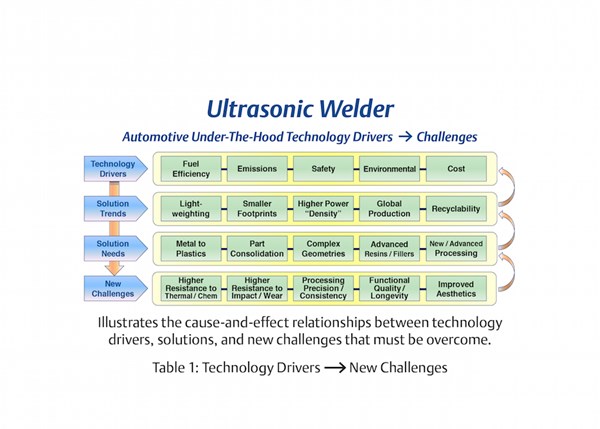What Is the Right Plastics Joining Process for You? Part 1
Changing demands, advancing technology and a process-neutral approach to plastics joining for under-the-hood automotive parts.
It has been over 25 years since polyamide was used in place of cast aluminum for the first time in a mass-production, air intake manifold in the U.S. Since then, replacing metal components with plastics in automotive under-the-hood applications has become a continuing trend.
In recent years, key technology drivers, led by fuel efficiency and emissions reduction, have presented tougher challenges, demanding innovative design solutions that rely on advances in engineered polymers and processing.

Success so far has been a result of the industry redesigning parts and assemblies for plastics, and not simply replacing metal components one by one. Design teams have had to engage resin suppliers and processing equipment suppliers at early stages of development to achieve optimization between part design, resin material and processing.
We have seen, for example, high-performance polymers like PPS and PPA replace metal in assemblies that are closer than ever to the engine combustion area. Here again, success has been the result of a team approach that simultaneously evaluates: materials with higher thermal resistance, the processing requirements of such materials and part design.
Given such complex challenges, when considering plastics joining solutions, it is important to understand the advantages and limitations of a wide range of joining technologies. Of equal importance, a “process neutral” approach should be adopted at the outset of the design phase and maintained while evaluating the many available technologies.
Plastics joining solutions providers should be engaged early to help determine the best fit for the application. This will dramatically improve the design, manufacturability and functional performance of the application, and it will reduce the risk of costly redesigns, rework of prototypes and scheduling delays caused by a lack of information about plastics joining technologies.
In the next segment, I will offer an overview of certain plastics joining technologies deployed in under-the-hood applications that involve engineered and high-performance polymers. In the third and final segment, I will present a sample application to illustrate the thought process used to determine the most appropriate solution.
About the author: Craig Birrittella holds the position at Emerson as Automotive Segment Manager, Americas, for Branson Ultrasonics, Danbury, Conn. Graduating from State University of New York at Buffalo with a mechanical engineering degree, Craig holds a patent related to using a lens to adapt laser intensity for uniform welding. Emerson is a global manufacturer of Branson Ultrasonics material joining and precision processing equipment. He can be contacted at Craig.Birrittella@Emerson.com.
Related Content
-
Next Generation of Ultrasonic Bonding Technology
Dukane’s Infinity family boasts accurate control maintained through all phases of the welding process.
-
Next-Generation Fully Electric Ultrasonic Welding System
NPE 2024: Rinco new eMotion servo-driven machine is available in 20 kHZ and 35 kHz frequencies.
-
All-Motor Driven Pad Printing Machine
Deco Technology now selling the new ML-500E linear & servo motor driven from microPrint of Switzerland












